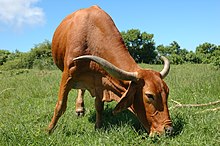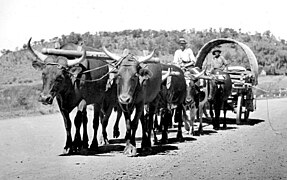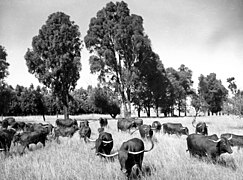437:
407:
422:
1128:
638:
47:
459:
Afrikaners are used commercially to produce beef, and are often crossbred with other breeds in order to improve meat quality, particularly in regards to tenderness, as well as their greater ability to add weight on poor quality forage. The South
African breed society promotes the use of Afrikaners as
301:
The
Afrikaner was the most abundant cattle breed in South Africa until the 1970s, however, problems associated with inbreeding, lowered fertility and decreased reproductive period in cows decreased their popularity among local farmers. Crossbreeding with exotic cattle breeds may have also contributed
375:
Afrikaners have good fertility, and can continue to calve over the age of 16 years, with records showing cows calving at 21. The cows are very maternal, and one female will often care for a number of calves while their mothers graze elsewhere. They have few calving problems, due to the structure of
371:
in their skin are more active than those of taurine cattle. This makes them more tolerant of heat than
European breeds. They are more economical to keep, and a greater number of Afrikaners can be kept on the same plot of land as European cattle. They have a good temperament and are easy to handle.
281:
The breed almost became extinct in the early 20th century during the Second Boer War, their numbers depleted through destruction and due to an outbreak of
Rinderpest that halved the country's total cattle population. After the war, programs were put in place to improve the breed.
294:
by the
Africander Cattle Breeders' Society of South Africa. The first five Afrikaners arrived in Australia in 1953 and were taken to the CSIRO's Belmont station for research into their adaptability to the Australian climate. They were imported from Texas and Florida.
387:
The
Khoikhoi used the Afrikaners for meat and milk. Afrikaners were used primarily as draught animals after European settlement, often driven in large teams with as many as 14 animals. They were bred and developed to better suit this purpose, and were prized by the
1105:
285:
In 1912, the first
Afrikaner studbook was formed in South Africa in order to control the breed's development. However, due to the recently depleted numbers of Afrikaner cattle, a high degree of inbreeding occurred at this time.
392:. They were also used as dairy cows, though less commonly, producing higher butterfat contents than other cattle breeds, without the need for supplementary feed. It was Afrikaner oxen which drew the wagons that carried the
289:
In 1923, it was proposed that
Afrikaners be sent to the United States, and in 1932, the US government imported a herd to introduce new blood to the Gulf Coast. In 1929, a bull and two cows (one a calf) were gifted to the
436:
277:
breeds. They most likely diverged 655–960 years ago. Anecdotal evidence from
Portuguese sailors suggest that herds of Afrikaner-like cattle had been kept by the Khoikhoi since at least the 15th Century.
489:
406:
1070:
Vercoe, J; Frisch, J; Moran, J (1972). "Apparent digestibility, nitrogen utilization, water metabolism and heat tolerance of
Brahman cross, Africander cross and Shorthorn x Hereford steers".
964:
421:
1300:
298:
During the first half of the 20th century, Afrikaners were being bred to reduce the size of their hump, as this was unsightly to farmers used to the taurine cattle shape.
324:
The Afrikaner is a well-muscled animal, with long legs and a shallow body. The horns are long and lateral, variable in both shape and placement; there is a
367:
The legs are slightly sickle shaped. They have good resistance to tick-borne diseases. They are well adapted to the local hot, arid conditions, as the
1196:
379:
There is a medium to high degree of genetic variation within this breed with a low inbreeding coefficient, despite the historic decline in numbers.
1054:
597:
1280:
585:
549:
1057:. Domestic Animal Diversity Information System of the Food and Agriculture Organization of the United Nations. Accessed June 2023.
600:. Domestic Animal Diversity Information System of the Food and Agriculture Organization of the United Nations. Accessed June 2023.
1001:"The patterns of admixture, divergence, and ancestry of African cattle populations determined from genome-wide SNP data"
254:
500:. They were bred in an effort to produce a breed that was better suited to beef production in hot, dry areas.
965:"Long-term selection experiment with Afrikaner cattle 1. Environmental factors affecting calf growth traits"
1127:
637:
1295:
701:"Extent of Linkage Disequilibrium and Effective Population Size in Four South African Sanga Cattle Breeds"
234:
615:
274:
1087:
447:
443:
428:
325:
191:
31:
1276:
1032:
732:
581:
545:
475:
413:
376:
their hindquarters and small calf sizes (30–35 kg). They have a low calf mortality rate.
999:
Gebrehiwot, N. Z.; Strucken, E. M.; Aliloo, H.; Marshall, K.; Gibson, J. P. (December 2020).
504:
1117:
1079:
1022:
1012:
972:
722:
712:
627:
303:
614:
L. Pienaar, J.P. Grobler, F.W.C. Neser, M.M. Scholtz, H. Swart, K. Ehlers, M. Marx (2014).
253:(Hottentot) people which were already present in the area of modern South Africa when the
1027:
1000:
727:
700:
508:
317:
Afrikaners are usually deep red. They have the small cervical-thoracic hump typical of
1171:
1289:
616:
Genetic diversity in selected stud and commercial herds of the Afrikaner cattle breed
516:
512:
1091:
574:
Valerie Porter, Lawrence Alderson, Stephen J.G. Hall, D. Phillip Sponenberg (2016).
671:
393:
389:
318:
270:
246:
488:
cattle are the result of crossing Afrikaners with Herefords and Shorthorns by the
575:
539:
493:
485:
368:
258:
1017:
1248:
1083:
977:
938:
911:
828:
802:
776:
497:
468:
Crossbreeding with Afrikaners increases the heat tolerance of taurine breeds.
397:
46:
1222:
1145:
1106:
The fasting metabolism of Brahman, Africander and Hereford X Shorthorn cattle
885:
859:
750:
717:
520:
479:
1036:
736:
631:
17:
471:
302:
to the decline in population numbers, as well as the introduction of the
291:
250:
242:
52:
1121:
353:
238:
206:
1275:(3rd ed.) Australian Meat & Livestock Corporation, Sydney,
249:
group of African cattle. It is derived from the cattle of the
577:
Mason's World Encyclopedia of Livestock Breeds and Breeding
309:
Current Afrikaner cattle have about 4% European ancestry.
1150:
The Afrikaner Cattle Breeders' Society of South Africa
676:
The Afrikaner Cattle Breeders' Society of South Africa
519:. An Afrikaner–Angus cross developed in the 1930s in
30:"Africander" redirects here. For the racehorse, see
1055:
Breed data sheet: Afrikaner / South Africa (Cattle)
328:variant. Average weights are variously reported at
181:
173:
148:
105:
100:
92:
84:
76:
59:
523:– sometimes called Africangus – was unsuccessful.
474:cattle are the result of crossing Afrikaners with
177:usually dark red; light red and yellow also seen
8:
854:
852:
850:
39:
860:"Africander Cattle: A History of the Breed"
507:is a modern 50–50 hybrid of Afrikaner and
45:
38:
1301:Cattle breeds originating in South Africa
1065:
1063:
1026:
1016:
976:
963:Beffa, L; van Wyk, J; Erasmus, G (2009).
726:
716:
610:
608:
606:
1140:
1138:
694:
692:
482:. They were developed during the 1960s.
969:South African Journal of Animal Science
939:"Africander Cattle Might Do Well in NT"
620:South African Journal of Animal Science
531:
402:
1050:
1048:
1046:
777:"The Rural Industries of South Africa"
666:
664:
662:
660:
658:
656:
654:
652:
650:
648:
570:
568:
566:
564:
562:
560:
558:
427:An Afrikander Wagon Transport in the
412:An Afrikander Wagon Transport in the
269:Afrikaners share coancestry with the
7:
829:"Beef Cattle World and Meat Markets"
580:(sixth edition). Wallingford: CABI.
1072:The Journal of Agricultural Science
544:. Doetinchem, Netherlands: Misset.
511:, with some influence of Bonsmara,
25:
344:for cows; bulls may grow to over
1273:Handbook of Australian Livestock
1126:
636:
435:
420:
405:
1249:"Rare calf born at S.A. school"
598:Transboundary breed: Africander
442:Pure Bred Afrikander Cattle at
755:Clarence and Richmond Examiner
541:Cattle Breeds: An Encyclopedia
460:a dam line for crossbreeding.
1:
1170:Haggard, H (10 August 1889).
1110:British Journal of Nutrition
626:(5, supplement 1): S80–S84.
1271:Timmins, Lisa (ed.) (1989)
699:Makina, Sithembile (2015).
1317:
1018:10.1186/s12864-020-07270-x
29:
1084:10.1017/s0021859600025375
978:10.4314/sajas.v39i2.44384
886:"Test Cattle for Belmont"
352:. Average heights at the
201:
44:
718:10.3389/fgene.2015.00337
348:, and cows to more than
255:Dutch East India Company
1223:"Africander Dairy Cows"
937:B, R (4 October 1941).
912:"Stud Cattle For Tests"
538:Marleen Felius (1995).
1172:"King Solomon's Mines"
833:The Farmer and Settler
751:"South African Cattle"
632:10.4314/sajas.v44i5.16
88:nine African countries
1176:Darling Downs Gazette
705:Frontiers in Genetics
313:Breed characteristics
1253:Victor Harbour Times
1146:"Why Invest with us"
1104:J.E. Vercoe (1970).
306:to southern Africa.
1122:10.1079/bjn19700061
41:
1237:– via Trove.
1211:– via Trove.
1185:– via Trove.
952:– via Trove.
926:– via Trove.
900:– via Trove.
874:– via Trove.
843:– via Trove.
817:– via Trove.
791:– via Trove.
783:. 24 November 1906
765:– via Trove.
336:for bulls, and at
188:long lateral horns
133:average 525–640 kg
117:average 745–955 kg
32:Africander (horse)
1229:. 7 November 1896
918:. 17 January 1953
892:. 16 January 1953
414:Orange Free State
223:
222:
77:Country of origin
16:(Redirected from
1308:
1265:
1264:
1262:
1260:
1245:
1239:
1238:
1236:
1234:
1227:Morning Bulletin
1219:
1213:
1212:
1210:
1208:
1193:
1187:
1186:
1184:
1182:
1167:
1161:
1160:
1158:
1156:
1142:
1133:
1131:
1130:
1102:
1096:
1095:
1067:
1058:
1052:
1041:
1040:
1030:
1020:
996:
990:
989:
987:
985:
980:
960:
954:
953:
951:
949:
943:The Australasian
934:
928:
927:
925:
923:
908:
902:
901:
899:
897:
890:Morning Bulletin
882:
876:
875:
873:
871:
856:
845:
844:
842:
840:
835:. 2 January 1932
825:
819:
818:
816:
814:
799:
793:
792:
790:
788:
773:
767:
766:
764:
762:
747:
741:
740:
730:
720:
696:
687:
686:
684:
682:
668:
643:
641:
640:
612:
601:
595:
589:
572:
553:
536:
439:
424:
409:
363:
359:
351:
347:
343:
339:
335:
331:
257:established the
215:
209:
49:
42:
21:
1316:
1315:
1311:
1310:
1309:
1307:
1306:
1305:
1286:
1285:
1268:
1258:
1256:
1247:
1246:
1242:
1232:
1230:
1221:
1220:
1216:
1206:
1204:
1195:
1194:
1190:
1180:
1178:
1169:
1168:
1164:
1154:
1152:
1144:
1143:
1136:
1125:
1103:
1099:
1069:
1068:
1061:
1053:
1044:
998:
997:
993:
983:
981:
962:
961:
957:
947:
945:
936:
935:
931:
921:
919:
910:
909:
905:
895:
893:
884:
883:
879:
869:
867:
858:
857:
848:
838:
836:
827:
826:
822:
812:
810:
801:
800:
796:
786:
784:
775:
774:
770:
760:
758:
749:
748:
744:
698:
697:
690:
680:
678:
670:
669:
646:
635:
613:
604:
596:
592:
573:
556:
537:
533:
529:
466:
457:
450:
440:
431:
425:
416:
410:
385:
361:
357:
349:
345:
341:
337:
333:
329:
315:
267:
219:
214:Bos primigenius
213:
205:
197:
169:
166:
165:
158:
144:
141:
140:
139:
124:
123:
120:to over 1100 kg
72:
55:
35:
28:
27:Breed of cattle
23:
22:
15:
12:
11:
5:
1314:
1312:
1304:
1303:
1298:
1288:
1287:
1284:
1283:
1267:
1266:
1255:. 16 June 1977
1240:
1214:
1203:. 9 March 1893
1201:Cobram Courier
1197:"Two Warnings"
1188:
1162:
1134:
1116:(3): 599–606.
1097:
1059:
1042:
991:
955:
929:
903:
877:
866:. 11 July 1929
846:
820:
809:. 10 July 1923
794:
768:
742:
688:
644:
602:
590:
554:
530:
528:
525:
509:Aberdeen Angus
465:
462:
456:
453:
452:
451:
441:
434:
432:
426:
419:
417:
411:
404:
384:
381:
364:respectively.
314:
311:
266:
263:
245:cattle in the
233:is an African
221:
220:
218:
217:
210:
202:
199:
198:
196:
195:
189:
185:
183:
179:
178:
175:
171:
170:
168:
167:
164:average 115 cm
163:
161:
159:
157:average 143 cm
156:
152:
150:
146:
145:
143:
142:
138:
137:
136:to over 800 kg
134:
130:
129:
127:
125:
122:
121:
118:
114:
113:
109:
107:
103:
102:
98:
97:
94:
90:
89:
86:
82:
81:
78:
74:
73:
71:
70:
67:
63:
61:
57:
56:
50:
26:
24:
14:
13:
10:
9:
6:
4:
3:
2:
1313:
1302:
1299:
1297:
1296:Cattle breeds
1294:
1293:
1291:
1282:
1281:0-642-87194-9
1278:
1274:
1270:
1269:
1254:
1250:
1244:
1241:
1228:
1224:
1218:
1215:
1202:
1198:
1192:
1189:
1177:
1173:
1166:
1163:
1151:
1147:
1141:
1139:
1135:
1129:
1123:
1119:
1115:
1111:
1107:
1101:
1098:
1093:
1089:
1085:
1081:
1077:
1073:
1066:
1064:
1060:
1056:
1051:
1049:
1047:
1043:
1038:
1034:
1029:
1024:
1019:
1014:
1010:
1006:
1002:
995:
992:
979:
974:
970:
966:
959:
956:
944:
940:
933:
930:
917:
913:
907:
904:
891:
887:
881:
878:
865:
861:
855:
853:
851:
847:
834:
830:
824:
821:
808:
804:
798:
795:
782:
778:
772:
769:
757:. 28 May 1901
756:
752:
746:
743:
738:
734:
729:
724:
719:
714:
710:
706:
702:
695:
693:
689:
677:
673:
667:
665:
663:
661:
659:
657:
655:
653:
651:
649:
645:
639:
633:
629:
625:
621:
617:
611:
609:
607:
603:
599:
594:
591:
587:
586:9781780647944
583:
579:
578:
571:
569:
567:
565:
563:
561:
559:
555:
551:
550:9789054390176
547:
543:
542:
535:
532:
526:
524:
522:
518:
514:
513:Drakensberger
510:
506:
501:
499:
495:
491:
487:
483:
481:
477:
473:
469:
464:Crossbreeding
463:
461:
454:
449:
445:
438:
433:
430:
423:
418:
415:
408:
403:
401:
399:
395:
391:
382:
380:
377:
373:
370:
365:
355:
327:
322:
320:
312:
310:
307:
305:
299:
296:
293:
292:King George V
287:
283:
279:
276:
275:Drakensberger
272:
264:
262:
260:
256:
252:
248:
244:
240:
236:
232:
228:
216:
211:
208:
204:
203:
200:
193:
190:
187:
186:
184:
180:
176:
172:
160:
154:
153:
151:
147:
135:
132:
131:
126:
119:
116:
115:
111:
110:
108:
104:
99:
95:
91:
87:
83:
79:
75:
68:
65:
64:
62:
58:
54:
48:
43:
37:
33:
19:
1272:
1257:. Retrieved
1252:
1243:
1231:. Retrieved
1226:
1217:
1205:. Retrieved
1200:
1191:
1179:. Retrieved
1175:
1165:
1153:. Retrieved
1149:
1113:
1109:
1100:
1075:
1071:
1008:
1005:BMC Genomics
1004:
994:
982:. Retrieved
968:
958:
946:. Retrieved
942:
932:
920:. Retrieved
915:
906:
894:. Retrieved
889:
880:
868:. Retrieved
863:
837:. Retrieved
832:
823:
811:. Retrieved
806:
797:
785:. Retrieved
780:
771:
759:. Retrieved
754:
745:
708:
704:
679:. Retrieved
675:
623:
619:
593:
576:
540:
534:
502:
484:
470:
467:
458:
394:Voortrekkers
390:voortrekkers
386:
378:
374:
369:sweat glands
366:
346:1100 kg
323:
319:Sanga cattle
316:
308:
300:
297:
288:
284:
280:
268:
230:
226:
224:
212:
85:Distribution
80:South Africa
36:
494:Rockhampton
486:Belmont Red
362:115 cm
358:143 cm
350:800 kg
342:640 kg
338:525 kg
334:955 kg
330:745 kg
259:Cape Colony
182:Horn status
60:Other names
1290:Categories
1011:(1): 869.
527:References
498:Queensland
480:Shorthorns
455:Commercial
398:Great Trek
231:Africander
69:Afrikander
66:Africander
18:Africander
1078:: 71–74.
864:Chronicle
803:"Kelpies"
672:"History"
521:Louisiana
476:Herefords
448:Transvaal
429:Transvaal
261:in 1652.
227:Afrikaner
51:A cow in
40:Afrikaner
1259:27 April
1092:85134295
1037:33287702
807:The Land
781:Advocate
737:26648975
472:Bonsmara
251:Khoikhoi
243:indicine
162:Female:
128:Female:
53:Transkei
1028:7720612
916:The Age
728:4664654
711:: 337.
505:Afrigus
396:on the
354:withers
304:Brahman
265:History
239:taurine
194:variant
1279:
1233:22 May
1207:22 May
1181:22 May
1155:20 May
1090:
1035:
1025:
984:22 May
948:23 May
922:23 May
896:23 May
870:23 May
839:23 May
813:22 May
787:22 May
761:22 May
735:
725:
681:20 May
584:
548:
444:Ermelo
326:polled
207:Cattle
192:polled
155:Male:
149:Height
112:Male:
106:Weight
101:Traits
1088:S2CID
490:CSIRO
271:Nguni
247:Sanga
235:breed
1277:ISBN
1261:2017
1235:2016
1209:2016
1183:2016
1157:2016
1033:PMID
986:2016
950:2016
924:2016
898:2016
872:2016
841:2016
815:2016
789:2016
763:2016
733:PMID
683:2016
582:ISBN
546:ISBN
517:Tuli
515:and
503:The
478:and
383:Uses
360:and
356:are
273:and
225:The
174:Coat
96:beef
1118:doi
1080:doi
1023:PMC
1013:doi
973:doi
723:PMC
713:doi
628:doi
492:in
340:or
332:or
237:of
229:or
93:Use
1292::
1251:.
1225:.
1199:.
1174:.
1148:.
1137:^
1124:.
1114:24
1112:.
1108:.
1086:.
1076:79
1074:.
1062:^
1045:^
1031:.
1021:.
1009:21
1007:.
1003:.
971:.
967:.
941:.
914:.
888:.
862:.
849:^
831:.
805:.
779:.
753:.
731:.
721:.
707:.
703:.
691:^
674:.
647:^
634:.
624:44
622:.
618:.
605:^
557:^
496:,
446:,
400:.
321:.
1263:.
1159:.
1132:.
1120::
1094:.
1082::
1039:.
1015::
988:.
975::
739:.
715::
709:6
685:.
642:.
630::
588:.
552:.
241:-
34:.
20:)
Text is available under the Creative Commons Attribution-ShareAlike License. Additional terms may apply.



